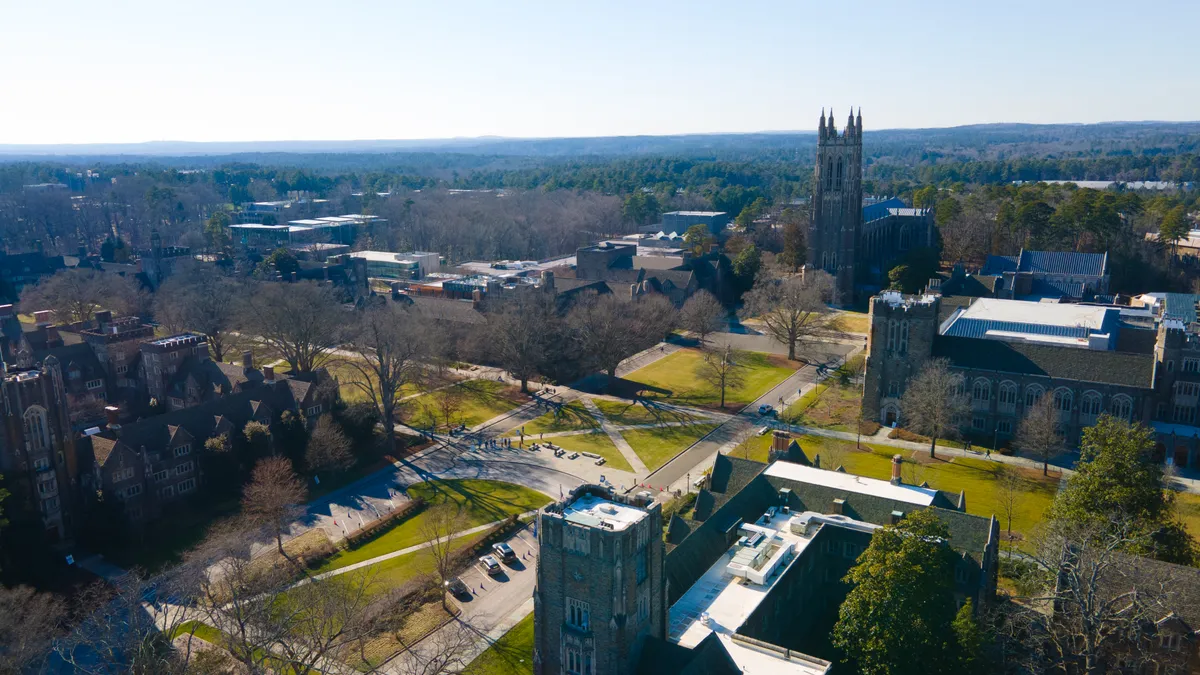For more than a decade, Keith Harmon has helped oversee a rare success story in higher education.
Harmon is the director of the Meyerhoff Scholars Program, an initiative started 30 years ago at the University of Maryland, Baltimore County that has helped the college make serious inroads bridging equity gaps in STEM education.
The idea behind the program is simple. With the right supports — namely, a sense of a community and regular advising — underrepresented students in STEM can go further in their education and careers. "We expect them to expect a lot of themselves," Harmon said. "There are high expectations, but they're also highly resourced."
So far it's working, with the program boasting more than 1,300 alumni, Harmon said, and studies showing participants are 5.3 times more likely to pursue and complete master's or Ph.D.s in STEM fields. (The program, which is open to applicants from all backgrounds, enrolls a majority of underrepresented students.)
The Meyerhoff program is just one of many aimed to increase diversity in STEM. Efforts like it have been critical to getting more Hispanic and black students in those fields, but more progress is needed. According to a new report by the American Council on Education (ACE), black and Hispanic students still significantly lag some of their peers in completing STEM programs.
Black students in particular face barriers to their completion, the researchers note, as they were among the least likely to enroll and complete a degree in STEM fields. Just 12.6% of black students who graduated with a bachelor's degree in 2016 did so with a STEM major, compared to 34.7% of Asian students and 20.5% of white students.
Graduate programs revealed similar disparities, with 6.2% of black students completing master's degrees in STEM fields in 2016, compared to 22.9% of Asian students and 10.7% white students. That same year, black students were also underrepresented in STEM doctoral programs, with 13.8% graduating in those fields, compared to 51.9% of Asian students and 35.5% of white students.
Hispanic students fared slightly better, though they were still behind some other groups. In 2016, 16.7% of bachelor's degree recipients and 9.2% of master's degree recipients graduated in a STEM field. In doctoral programs, Hispanic students' STEM attainment was much higher, with 30.7% graduating in those fields.
It's worth noting that students identifying as Native American as well as Native Hawaiian or other Pacific Islander also had lower levels of attainment across the board.
The reasons for these gaps are many, but chief among them is a lack of access to quality education. Data has shown K-12 schools that serve higher numbers of minority students tend to do so with fewer resources than those that serve mostly white students. That can have long-lasting effects, with many students exiting those schools unprepared for the rigors of STEM programs in college.
Black and Hispanic students also face entrenched stereotypes about which groups of students do well in STEM, possibly leading to lower expectations from professors. Compounding that problem is a lack of black and Hispanic instructors in STEM education.
In the face of these issues, colleges and organizations across the nation are recognizing that higher education is failing Hispanic and black students and that more supports are needed to make STEM programs equitable.
A sense of belonging
The way some STEM intro classes are set up stacks the cards against underrepresented minorities from the very beginning of college.
For one, a record number of students are flooding introductory computer science classes to get on the path to the high salaries the in-demand field offers. That's led to a shortage of qualified instructors to teach those classes, creating an incentive for some colleges to conduct them as "weed-out" courses rather than provide students with more support.
Many introductory classes also assume college students have had previous exposure to computer science in high school, which may not be the case for some underrepresented students, said Michael Ellison, the CEO and founder of CodePath.org, a nonprofit that develops computer science curriculum for colleges and students across the U.S.
"Once they (students) work alongside individuals at Google and realize that these individuals are no smarter than they are (and) no more professional than they are, they begin to understand that they are worthy of good jobs and are more motivated to do well."

Harry Keeling
Associate professor, Howard University
Such expectations can cause minority students who are considering a STEM major to change their minds and either switch programs or drop out of college entirely. Indeed, retention rates in such programs can be low, with the majority of students from underrepresented groups dropping out of computer science before they graduate, according to CodePath.org.
Completing college altogether, regardless of major, is also an area needing improvement. Fewer than half of black (44.5%), Hispanic (42.5%) and American Indian or Alaska Native (37.1%) students complete a bachelor's degree, compared to 57.2% of white students and 63.7% Asian students, according to the ACE report.
To combat these issues, CodePath.org has designed computer science courses that supplement a college's existing curriculum and provide underserved students with skills informed by the needs of top tech companies.
The company designed the courses to be turnkey, so in-person instructors don't need to be technical experts to teach the courses, Ellison said. So far, the nonprofit has partnered with more than 25 campuses — including the University of Arizona, Virginia Tech and Mount Holyoke College — to provide students with project-based classes that range from interview preparation for technical fields to mobile app design.
Colleges have also undertaken similar efforts to link industry with curriculum in order to improve student success in STEM. Howard University, for instance, is part of the Google in Residence program, which brings software engineers from the tech giant to teach introductory computer science classes at historically black colleges and universities (HBCUs).
Harry Keeling, a computer science professor at Howard, said the program has encouraged many students to stay in computer science and prompted other students to switch into the major.
The university also piloted a program, called Howard West, in 2017 that sent 26 students to Google's headquarters in California for three months of hands-on learning. Proving successful, it was expanded into a program called the Tech Exchange, which sends 65 students and several faculty members from HBCUs and Hispanic Serving Institutions (HSIs) to learn at the Google campus for a full academic year.
This kind of experience can be critical for students to feel like they belong in STEM fields, Keeling said.
"Students don't feel they are equipped to deal with the rigors of the career," Keeling said. "Once they work alongside individuals at Google and realize that these individuals are no smarter than they are (and) no more professional than they are, they begin to understand that they are worthy of good jobs and are more motivated to do well."
Leveling the playing field
Congress also has a big role to play in closing the gaps in STEM student achievement.
Under the Higher Education Act, for instance, some HSIs can obtain competitive grants to create better transfer pathways for community college students interested in studying STEM fields at four-year colleges. That's been critical in boosting the number of Hispanic students pursuing these degrees, said Antonio Flores, president and CEO of the Hispanic Association of Colleges and Universities (HACU).
Along with making the program permanent and increasing its funding, HACU is also urging Congress to dole out more funds to HSIs. HACU argues HSIs receive about two-thirds the funding other colleges get from federal sources on a per-student basis even though they serve more than 2 million Hispanic students, who are disproportionately first-generation and low-income.
"That's a huge gap when you're only getting two-thirds of what others get when the populations you serve are among the neediest," Flores said. "We just want them to level the playing field."

















